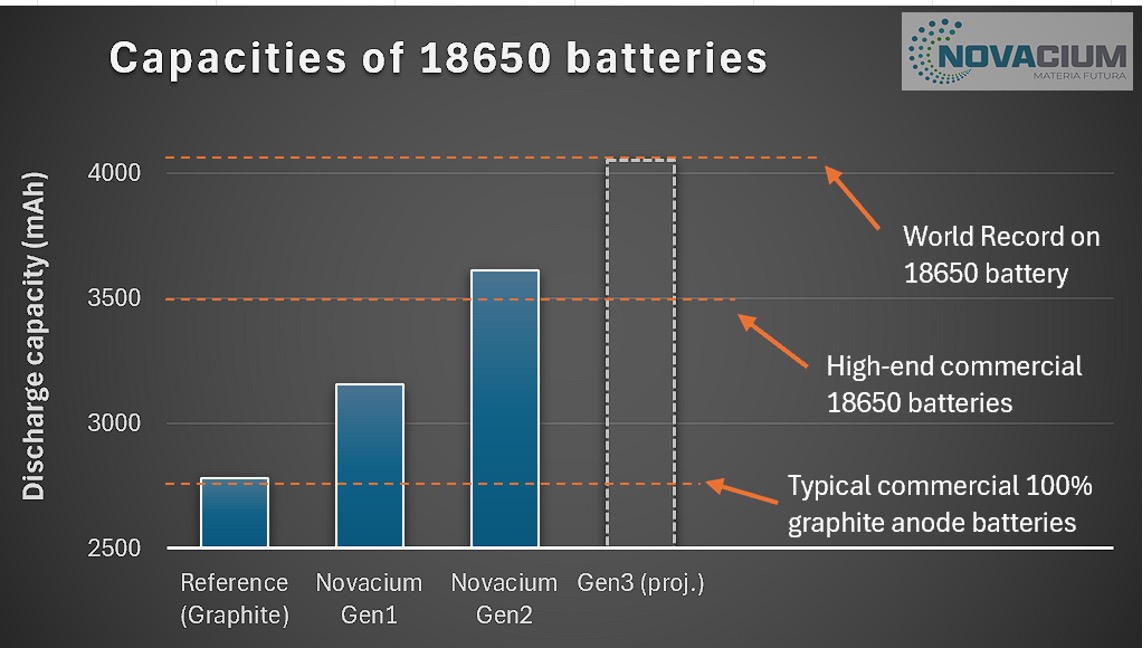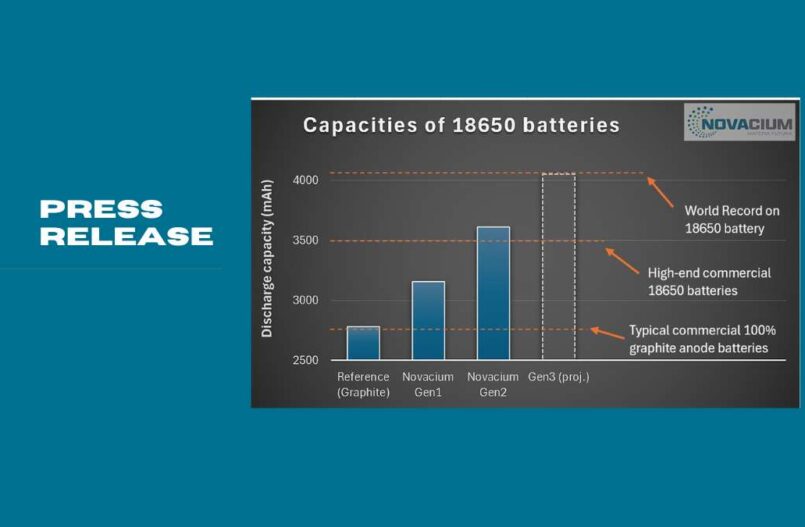- Preliminary testing results with Gen 2 material demonstrate a capability to improve performance by about 30% versus graphite benchmark and by 14% better versus Gen1 material [1].
- This improvement is achieved without noticeable first-cycle degradation [1].
MONTREAL, Canada — HPQ Silicon Inc. (“HPQ” or the “Company”) (TSX-V: HPQ) (OTCQB: HPQFF) (FRA: O08), a technology company specializing in green engineering of silica and silicon-based materials is pleased to announce the latest battery milestones achieved by its France-based affiliate, NOVACIUM SAS (“Novacium”).
This announcement highlights the remarkable results obtained during the first-cycle tests of 18650 industrial batteries made with Novacium’s non-optimized second generation of advanced silicon-based anode material. It also showcases Novacium’s capability to produce a blend of graphite and advanced silicon anode material that can be seamlessly integrated into existing anode manufacturing facilities to improve overall battery performance.
UNLOCKING ENHANCED BATTERY PERFORMANCE WITH SILICON DEPLOYMENT

The above table illustrates the progression from the reference 100% graphite battery capacity, approximately 2,780 mAh, typical for commercially available batteries with graphite anodes. It demonstrates the capacity increase to around 3,150 mAh with our first generation of advanced silicon-based material. Finally, the results from batteries utilizing our second generation of advanced silicon-based material showcase a further increase of average capacity to 3,610 mAh [1], with best-in-class value of 3,835 mAh, representing about 30% improvement versus the graphite benchmark and over 14% improvement versus first-generation results. The table also highlights that the world record for 18650 battery capacity presently is at 4,095 mAh [3].
“Our results to date are a powerful indication of the rapid progress of our work and the commercial potential of the materials we are developing. However, we are not finished, with intent to continue improving our material so that our third generation of advanced silicon-based material continue to improve our 18650-battery performance, with the aim to crack the 4Ah mark very soon” stated Dr. Jed Kraiem Ph.D., COO of Novacium. “These results continue to underscore our ability to produce a blend of graphite and advanced engineered silicon anode material that can be seamlessly integrated into existing anode manufacturing facilities. This blend can be utilized worldwide without modification by battery manufacturers, significantly enhancing battery performance.”
ADVANCING MARKET OPPORTUNITIES FOR SILICON-BASED ANODE MATERIALS
As pure graphite anodes have essentially achieved their maximum performance in terms of energy density [4], a trend in the lithium battery industry has been the introduction of small amounts (about 5%) of silicon oxide (SiOx) material into graphite composite electrodes. This basic SiOx material, primarily used in the fabrication of optical materials, sells for about US$15 per kg [5] and delivers less than optimal results.
While Silicon remains the most promising candidate for drastically improving the anode performance (more than 10 times), its industrial application is still very limited due to unresolved issues related to volumetric expansion or the usage of very complex and highly expensive solutions.
The manufacture of an engineered silicon-based anode material, such as the Novacium product, will enable the battery industry to overcome these problems and increase battery capacity without significant degradation of the battery’s lifetime. Currently the selling price of engineered silicon-based anode material is around US$75 to US$100 per kg [5]. The Si-C material made using CVD deposition of Silane material sells for about US$300 per kg [5], which is not feasible for massive industrial applications.
This new reality is driving a surge in demand for advanced silicon-based anode materials. As of 2023, this market is valued between US$1.1 billion [6] and US$2.7 billion [7]. Its growth prospects indicate a potential demand of 300,000 tons by 2030, estimated at US$15 billion [6], according to one source, and US$131.6 billion in 2033, according to another source [8].
It is important to highlight that silicon-based materials for Li-ion batteries currently make up a relatively small portion, accounting for less than 10%, of the global demand for graphite, which is primarily used in the manufacture of anode materials for Li-ion batteries. This graphite market is estimated to be worth US$25 billion in 2023 [9].
“I continue to be profoundly encouraged by the results to date; however, I am even more excited about the potential of our continual improved next generations of materials,” expressed Mr. Bernard Tourillon, President and CEO of HPQ Silicon Inc. and NOVACIUM SAS. “These achievements open the door for HPQ to become one of the first North American manufacturers of next-gen engineered silicon-based anode materials in a jurisdiction that supports these types of initiatives as it aims to become a central hub for battery material manufacturing in North America.”
REFERENCE SOURCES
[1] Novacium technical team analysis of the data from the ongoing charging and discharging cycle tests conducted at a world-leading university, the name of which is kept confidential for competitive reasons.
[2] https://www.ufinebattery.com/blog/the-18650-maximum-capacity/
[3] https://www.enpower-greentech.com/news/enpower-greentech-achieved-breakthrough-in-cylindrical-batteries
[4] The Royal Society of Chemistry 2020 Sustainable Energy Fuels, 2020, 4, 5387–5416
[5] Management estimates based on confidential price quotes received for materials by HPQ affiliated company.
[6] QY Research, SNE Research, Shinhan Securities / NBM June 2023 Deck page 11
[7] The global silicon anode battery market is likely to be valued at US$ 2.7 billion in 2023. From Future Market Insights Global and Consulting Pvt. Ltd.
[8] According to Future Market Insights, the global silicon anode battery market is estimated to reach US$ 131.6 Billion by 2033.
[9] Based on the analysis by Fact.MR, the global graphite market is valued to be US$ 25.9 billion in 2023 and it is expected to grow at a CAGR of 8.5% to reach US$ 58,6 billion by the end of 2033. Link to source.
About NOVACIUM SAS
Novacium is an HPQ – affiliated company started in Q3 2022. This green technology startup is based in Lyon, France and is a partnership with HPQ and three of France’s leading research engineers, Dr. Jed KRAIEM PhD, Novacium’s Chief Operating Officer (“COO”), Dr. Oleksiy NICHIPORUK PhD, Novacium’s Chief Technical Officer (“CTO”), and Dr. Julien DEGOULANGE PhD, Novacium’s Chief Innovation Officer (“CIO”). Novacium is a new Research and Development company which allows the researchers to develop their own technology in high added value fields connected to renewable energy, and allows HPQ Silicon Inc, a Canadian company, to expand the depth and reach of its technical team to help develop its silicon and new renewable energy projects.


Congratulations to the 3 of you ! I am still looking forward to reading Novacium’s business plan. It seems to me that HPQ is looking for incentives from the EU via “Impact Funding Europe”, where, in my opinion, a business plan would raise the interest of many investors ….